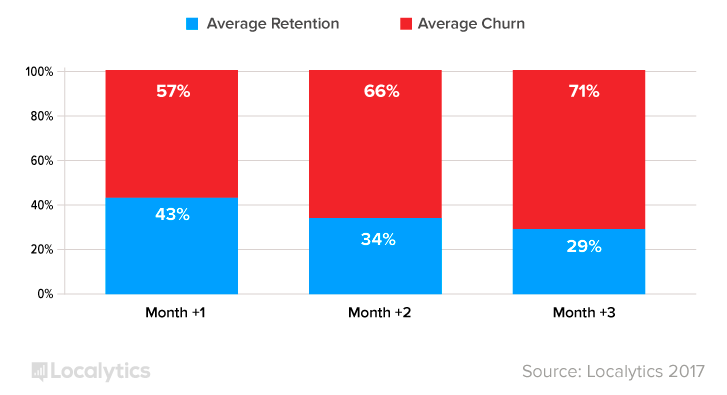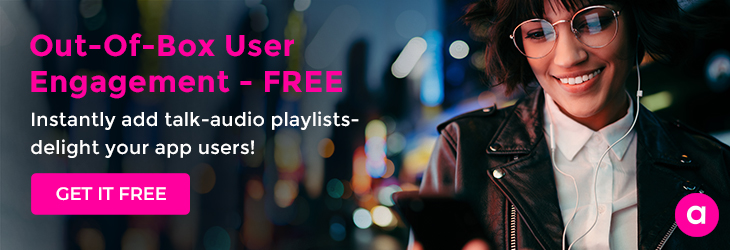If you’re in the mobile app business you already know that factoring user-acquisition is just the first step of making an app successful. One of the main challenges that app pros are still fully occupied with is related to optimizing user engagement and user retention metrics.
The newest Appsflyer report shows that on a macro level, iOS is the biggest winner when it comes to user retention. After reviewing the performance of 15K apps, Appsflyer found that iOS had a 35% higher retention rate than Android on week 8.
Here’s an image taken from the report download page:

There can be several reasons for this, but for the sake of our discussion, it shows that there’s clear room for Android apps to improve. And that’s just one metric.
I assume that all of us in the app business know everything there is to know about the ‘obvious’ mobile app engagement (and monetization) strategies that have been proven to work well, and experienced pros are very familiar with many of the tools and SDKs out there.
I don’t want to state the obvious all over again, but rather try to bring a few fresh angles and share some thoughts that can bring some value, maybe even to the most experienced app people 🙂
1. Know the field – what are good retention rates vs bad ones?
Benchmarks can help us understand where we stand compared to our competitors or the industry in general. Of course, benchmarks can never tell an accurate story, as they use big data and don’t refer to the uniqueness of different apps. For instance, you can’t expect the engagement parameters of a niche app that fits only specific occasions to be similar to those of a popular social media app, right?
Still, I believe that benchmarks should be nonetheless explored to set the ground for better understanding where your app stands compared to the market and how much you should invest in improving acquisition, usage or monetization metrics.
For instance Localytics is discussing “good retention rates” and ”bad retention rates” (in a 2018 article) and brings some benchmarks that retention managers must be aware of, in order to better understand the general landscape they are operating in.
Such benchmarks include the average number of users that will visit the app only once (21% one-time visitors in 2018!!)

Or the fact that after 29 days, over 70% of users churn, on average:

Now, mastering the app business means that in order to forecast the resilience of the app as a profitable business, there’s a need to look at industry averages for acquisition costs, retention metrics and monetization parameters (such as ARPDAU) – and calculate it all in.
Specifically, retention goals must be set in the right way, to ensure that the retention will be sufficient to establish the profitability. In other words, ask yourself if a scenario where you present numbers of an average app where 70% of your users will not stay longer than a month will still allow you to be profitable. That’s a demonstration of how to use known benchmarks in order to predefine goals and estimate how feasible these goals are.
Let’s compare between two apps:
App #1 is an alarm clock app. It is used for just a couple of minutes every morning. The ARPAU it can show is very low, and must ensure that users stick around for much longer than 29 days in order to have a positive ROI after the investment in user acquisition and workload.
Moreover, having just a couple of minutes of ‘passive usage’ every day is challenging from a monetization perspective – and retention efforts aren’t enough. There’s a clear need to shine when it comes to engagement parameters (such as session duration, for instance) and increase the return for every session. That can be done by expanding the functionalities of the app (like adding “local news” content as part of the experience)

App #2 is a DIY app. The first month is usually characterized by intensive usage, with nice and way above industry average engagement parameters. The main issue is user acquisition cost, because of the app niche functionality. By knowing the benchmarks for retention (as well as UA benchmarks), app business managers can decide if they can lean on the ‘regular’ acquisition channels and still focus on optimizing retention, or whether they should first focus on lower-cost acquisition channels that may be more worthwhile in their case.
So, to summarize: Mastering app retention and engagement is related to keeping updated with industry benchmarks, and setting goals that can be tough but still feasible.
2. Discover patterns of YOUR users drop-off
You already know that age, gender and other similar demographic user parameters that you may receive via 3rd parties (such as Facebook) are important for learning more about usage patterns and challenges with specific segments.
But it’s not nearly enough without running smart analytics to discover correlations.
When you find correlations between usage events, interests, and routines (such as time of day), you may get a lot smarter.
For example, what in-app actions are more common at different times of the day? Is there a change in retention between weekdays versus weekends for specific segments only? Do your night installs behave the same as your day ones?
I recently supported an app in analysing retention patterns.We managed to identify specific parameters that could be filtered to create specific segments, and discovered significant differences in retention. We figured that these differences represented different age groups, so we ran a couple of acquisition campaigns that aimed to tag users from different age groups more accurately and methodically. It helped us reaffirm our hypothesis.
As a result, we learned that we had a specific retention problem among relatively young users. It helped us finetune the app to better serve teenagers, but we also optimized our acquisition to focus on better retained segments.
Focusing on the person behind the user-journey forces app creators and publishers to try and understand their mobile app users on a granular level, which in turn leads to significant increases in retention and ROI. Many actions, tiny improvements and a tedious process. There’s no other way. Brace yourselves.
Another case I can share: Campaigns targeting early adopters brought nice retention rates, while “regular users” were more likely to ditch before completing the onboarding. We realized that onboarding was just too demanding for the average user So we shifted some of the learning to the pre-install page (by adding specific preview videos to the app download page), shortened the onboarding process, and sent a notification with advanced usage guidelines.
It may sound obvious, but it’s a pattern that took some data digging and a few trials to get right.
3. Everybody talks gamification, but how is it done for a non-game app?
When it comes to getting users engaged with your apps, gamification is a very effective approach. Here are some examples for inspiration:
Take todoist, for example: It’s a productivity app that gives you karma points for completed tasks, and negative karma for missed deadlines. And who wants to have a bad karma, right?
Timehop is an app designed to help people find new ways to connect with each other around the past. The more consecutive days you’ve shared a memory, the longer your sharing streak. And we all love winning streaks.
Duolingo is an app that helps you learn a foreign language. It has a set of gaming interactions that allow users to track their progress and practice their linguistic skills. You earn points for correct answers, race against the clock, and level up.
People love games, being rewarded and tracking progress. Find a way to praise your users on actions and give them a virtual gem they can collect and brag about, and you’ll increase your user engagement and retention rates. Think in terms of small rewards, badges, or progress indicators.
4. Effortlessly enrich your app with dynamic content layers
Obviously, user generated content (UGC) is powerful. It’s the holy grail, getting amazing content that users create. In a fitness app, for example, it means having a lot of training options that contain detailed descriptions of the process with actionable steps. UGC tremendously enriches your app with little to no effort on part of app advertisers, so its appeal is clear. However, it’s mostly applicable for social apps.
But what if I can’t have UGC?
Most apps can’t develop a UGC strategy. Alarm clock apps, nutrition, step counting, directories…
Let’s face it, most of us are dealing with apps that are desperate for dynamic content that will enrich its static functionalities and make users keep logging in and stay for longer; but for most of us, creating such content or leaning on UGC isn’t feasible.
Well, this is where the creative concept of adding Content SDKs comes in handy.
Audioburst for instance (yes, that’s us, no hiding here) offers app-publishers a super easy way to implement a free SDK, which lets them add talk-audio-bursts (bursts= highlights) that fit their app and audience to their app’s UX.
The bursts (playlists) are customized to the audience’s taste and app functionality. A few examples? Sure, you know my style:
- Think about an alarm clock app that all of a sudden offers its users to wake up with the local news.
- Or a nutrition app that can now enrich its users’ experience with lifestyle talk audio playlists discussing hot lifestyle topics.
- Or a fitness app that let’s users listen to health audio-burst talks while they exercise.
The sky’s the limit.
Dynamic content serves to empower both retention and engagement, and in this Audioburst use case it adds a whole new monetization layer that doesn’t interfere with the others.
Moveover, as long as the playlist categories are rich enough to match the app and the users AND there’s no effort in the integration – it’s a win-win for all parties.

5. What about retargeting your users through referral programs?
Referral programs could offer an interesting way to motivate users to keep using your app. Launching a referral program with a complimentary app can definitely help boost user engagement.
Interestingly enough, data shows that 30-40% of referring user traffic is sent to a previously downloaded app, making referrals a key re-engagement channel as well as a growth engine.
Let’s say that your app is focused on nutrition or fitness. You could run co-marketing activities together with another (non competing) diet or exercise app. They would deep-link your app into their content, and once you give users the incentive to click, they would seamlessly go to your app and vice versa.
This is a specific example designed to increase the usage of active users in both apps and their retention. Another known use case is deep linking to a GPS navigation app after the user has entered a point of interest on any location app.
Bottom line
It used to be that the user acquisition KPI was the key for maximizing app monetization.
Today, we know that the key and challenge lies in user engagement and retention. Now the goal is clear: Increase user retention. The tools at your disposal are endless: gamification, content enrichment, data mining and more. The challenge is to do it right for your specific app while focusing on user engagement.



